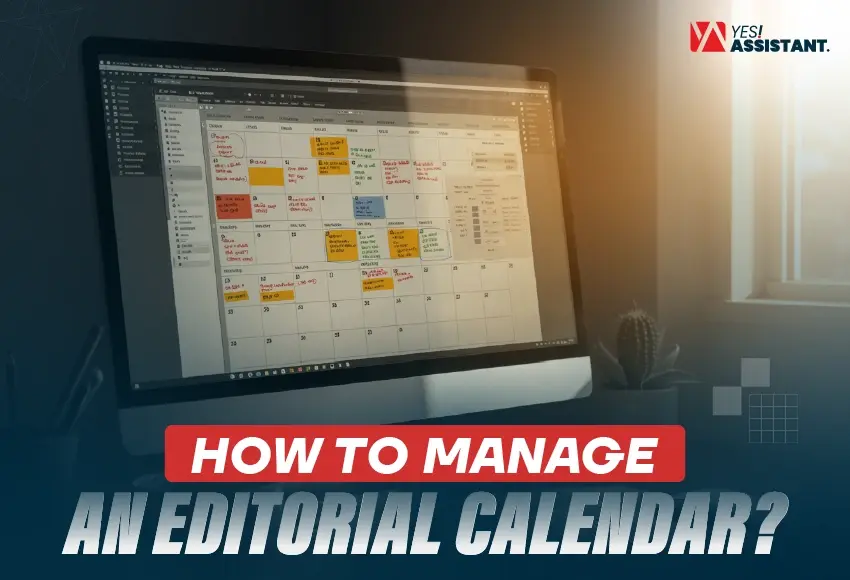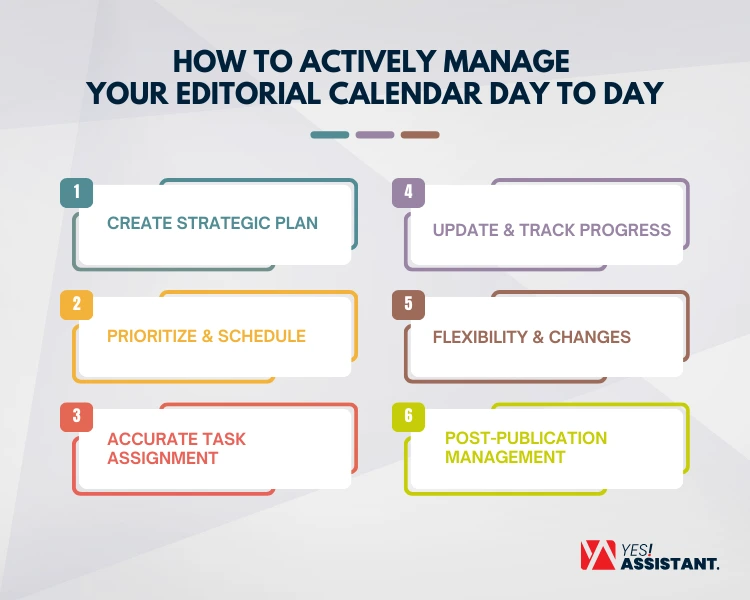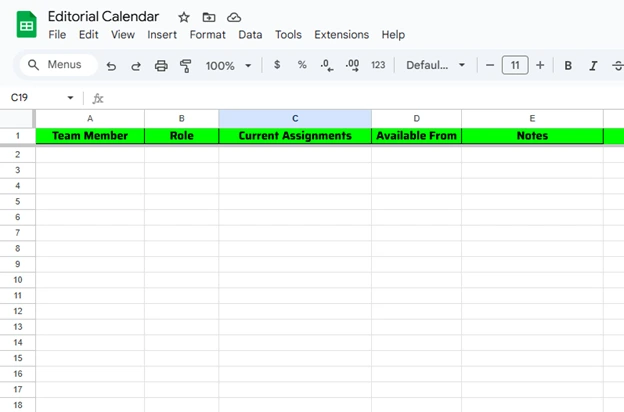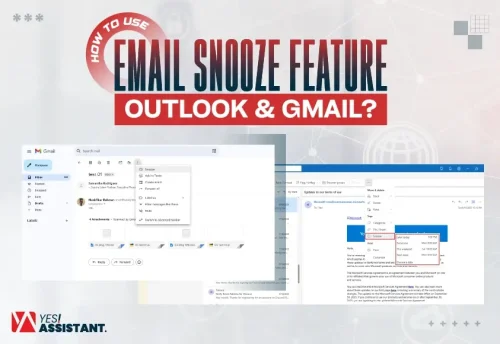
How to Manage an Editorial Calendar Effectively
A well-organized editorial calendar impacts the overall growth and performance of the entire management team. So, strategically maintaining the editorial calendar is highly significant for you, especially if you are working with a virtual assistant service team.
For that reason, in this article, we will go through an in-depth discussion about the editorial calendar. These are our core discussion points –
- Setting Up the Editorial Calendar for Faster Growth.
- Using project management tools like Trello, Clickup, Asana, etc.
- Choose specialized calendar tools like CoSchedule or Loomly.
- How can you Accurately Manage the Editorial Calendar(Step-by-step Process)
We can assure you that you will learn a lot about managing the editorial calendar properly.
What's Inside
- Setting Up Your Editorial Calendar for Success
- Essential Information to Include (Key Calendar Fields)
- How to Actively Manage Your Editorial Calendar Day-to-Day
- Best Practices for Effective Editorial Calendar Management
- Common Challenges in Managing an Editorial Calendar (and How to Overcome Them)
- Conclusion
Setting Up Your Editorial Calendar for Success
An editorial calendar is more than just a list of blog post ideas or deadlines. From start to finish, it’s a full system for planning, organizing, and managing content creation.
Spreadsheets (Google Sheets, Excel)
Content planning often starts by using spreadsheets and for a good reason. They are simple, familiar, and easy to set up.
Pros:
- Most people have access to Google Sheets or Excel. Sheets are available for use when you have internet access with a Google account, and it doesn’t cost money. You can get started right away. You can also integrate the Google Calendar with Sheets for a better management process.
- You create your calendar just how you like it, and you can add columns for publication dates, authors, status, keywords, etc.
- Avoid the effort of learning a new tool. If you have been using a spreadsheet, you are already familiar with it.
Cons:
- Everything must be entered and updated manually. That can be time-consuming and easy to overlook.
- Google Sheets supports real-time collaboration but tends to get messy when multiple users edit at the same time.
- There are no automated reminders about deadlines or notifications for team members when something else changes within a spreadsheet.
Project Management Tools (Trello, Asana, Monday.com, ClickUp)
These platforms are designed around work/task management but do great with content calendars, especially with teams.
Pros:
- Trello provides Kanban boards, Asana list and timeline views, and ClickUp for all calendars and Gantt charts. These tools visualize what’s going on, letting you see at a glance.
- Delegate work to writers, editors, or designers. Add due dates, comments, checklists, and attachments, all in one place.
- The majority of tools will allow you to set a task’s status (for example, “In Progress”, “Editing”, or “Published”) and will automatically update when needed.
- You won’t miss a deadline because the tool is going to remind you.
Cons:
- Basic plans may be free, but you may have to pay for advanced automation, dashboards, or integrations.
- Although they are powerful, platforms such as ClickUp and Monday, the learning curve for using com can be huge at the beginning, especially if you don’t require all their functionality. Another effective way to set up the calendar is with Notion, a renowned project management tool.
- If you are publishing only one or two posts a week, these tools may seem too complicated.
Specialized Calendar Software (CoSchedule, Loomly, etc.)
If content is central to your business, it may be worth investing in a tool designed specifically for editorial and marketing calendars.
Pros:
- Focus on scheduling tools so, ideally, you will use a tool like CoSchedule or Loomly to plan everything and schedule everything where you actually publish the content to WordPress or Facebook or LinkedIn, etc.
- A lot of these tools come with built-in analytics that let you measure how your content is doing once it’s published.
- These platforms rely heavily on workflows, approval processes, libraries of assets, templates of content and shared calendars.
- Everything is designed with content creators in mind, be it about managing a blog post or social media campaigns.
Cons:
- These tools charge monthly or yearly and can be expensive, particularly for small teams or single individuals.
- If you only need to schedule blog content, the additional features may be overkill.
- You have to take time to set it all up, connect accounts, and train your team.
Essential Information to Include (Key Calendar Fields)
While creating the editorial calendar, you must focus on some key factors. It will help you to keep all the necessary data aligned and formatted.
In this section, we are going to share with you some of the core fields that should be included on the editorial calendar.
Publication Date (and Time)
This is the most important field on your calendar. It tells you when part of the content is expected to go live.
Why it matters:
- Maintain consistency in your publishing.
- Assists with planning content for various campaigns, events, or product launches.
- Has the team met clear deadlines?
Also, include the exact time, particularly for social posts or anything else that could be time-sensitive.
Working Title / Topic Idea
Details of the draft title or what your content is about It allows you to quickly comprehend what the piece is about.
Why it matters:
- Provides the team with a getaway summary.
- Provides order while you brainstorm lots of ideas.
- It may be tweaked later in the editing phase.
For example, don’t just put “Email Tips,” put “10 Email Marketing Tips That Will Increase Your Open Rates.”
Content-Type
Be sure to include what type of content it is, i.e. blog post, video, social media post, podcast, infographic, case study, etc.
Why it matters:
- Assist with content variety planning.
- Involves the right people (copywriters, designers, video editors).
- Helps balance long-form and short-form content.
Author / Assignee
Who makes this content? Defining appropriate ownership reduces opacity.
Why it matters:
- Asks for accountability from their team members.
- Makes communication easier.
- Speeds up the workflow.
If multiple people are involved (e.g., writer, designer, editor), you can list all key contributors.
Status
Follow the progress of every content. Use clear stages like:
- Idea
- Outlined
- Drafting
- Editing
- Approved
- Scheduled
- Published
- Promoting
Why it matters:
- Provides a snapshot of your complete content pipeline.
- Keeps teams informed on what is complete and what still needs action.
- Ensures the content keeps flowing through the workflow.
Also, color-code each status to identify bottlenecks at a glance.
Target Audience / Persona
Who is this content for? Highlight the audience segment or persona.
Why it matters:
- Helps keep content on track and valuable.
- Establishes the tone, language, and messaging appropriate for your audience.
- Designers use it to align content to marketing goals.
For instance, rather than “marketers,” you could say “Small business owners looking to grow with email marketing.”
Target Keyword(s)
Enter the keyword(s) for which you want the content to be ranked in search engines.
Why it matters:
- Assists writers in implementing SEO best practices.
- Keep your content in line with your SEO plan.
- Better discoverability on Google and other search engines.
Also, do not forget to add secondary keywords or long-tail phrases if required.
Call to Action (CTA)
What behaviors do you want your readers to adopt post-consumption? Then, add your call-to-action – download, subscribe, comment, share, sign up, etc.
Why it matters:
- Helps guide user behavior.
- Aligns with business objectives such as lead generation or sales.
- Ensures your content stays on track.
For example: “Download our free content calendar template” or “Subscribe to our newsletter for more tips.”
Distribution Channels
What kind of content will be shared? List all platforms like:
- Your website or blog.
- Social media (Twitter, Facebook, Instagram, LinkedIn). Which are considered social media marketing content.
- Email newsletter.
- YouTube, podcast apps, etc.
Why it matters:
- Make sure your content has the right audience.
- Aids in scheduling and planned promotion
- It helps the team members to coordinate marketing efforts.
- Need points / Assets need supporting visuals.
A list of any images, graphics, videos, infographics, or documents needed to complete the content.
Why it matters:
- Allows designers and content creators to prepare assets beforehand.
- Eagles out the delay publishing.
- Guarantees consistency for the visuals over the platforms.
Relevant Links
Add all relevant active links associated with the content:
- Link to Word Doc / Google Docs draft / WordPress draft, etc.
- URL (once live)
- A research document written using primary, secondary, and/or tertiary data.
Why it matters:
- Collect everything you need in one spot.
- Further facilitates reviewing and editing.
- Makes managing and repurposing content easier later
Notes / Brief
Insert additional background information the team needs to be aware of, such as goals for the content, tone guidelines, internal notes, or specific instructions from clients.
Why it matters:
- Reduces confusion and assists in keeping the team on track.
- Provides context for stable collaboration.
How to Actively Manage Your Editorial Calendar Day-to-Day
A well-organized editorial calendar is always efficient for raising the overall growth of the content strategy and the conversion of the entire business. In this part, we will discuss the step-by-step process of managing the editorial calendar effectively.

Step 1: Strategic Planning & Ideation
This is the part where you get creative and load your calendar with new, significant content ideas.
Why it matters: Having a clear strategy and pipeline of ideas helps keep your content process organized and proactive rather than feeling scattered or reactive.
What to do:
- For start, you can grow the keyword using tools available, such as Google Keyword Planner, Ubersuggest, or Semrush.
- Look over your competitors’ content and identify gaps you can address.
- Collect questions from customers or prospects via emails, comments, forums, or social media.
- Organize content around dates, new product launches, campaigns, or awareness days.
How to do it in Google Sheets:
- Make a tab called “Content Ideas”.
- Make sure to have these columns: Idea / Working Title, Target Keyword(s), Target Audience, Content Format, Funnel Stage (Awareness, Consideration, Decision), Notes, or Source Links.
- Write down all your ideas in this sheet, and sort them using a “Priority”

Step 2: Scheduling & Prioritization
This step consists of arranging your thoughts into a general content timetable and preventing deadline confusion.
Why it’s important: Publishing content in a random form creates inconsistency. A properly prioritized schedule makes sure you are reaching the right audience at the right time.
What to do:
- Determine your frequency of publishing (e.g., “Two blogs per week and one newsletter per month”).
- Select your publishing dates that align with your team workload and campaign requirements.
- Include seasonal, trending, or promotional content when topical.
Managing in Google Sheets:
Make a master tab called “Editorial Calendar” with columns:
- Publication Date
- Working Title
- Content-Type
- Status (Idea, Writing, Editing, Scheduled, Published)
- Assigned To
- The platform (Blog, Youtube, LinkedIn, Instagram)
- Priority
- Sort by date with the SORT function.
- Make it easier to navigate if you freeze the top row and apply filters.

Step 3: Assigning Tasks & Responsibilities
With your content scheduled, it’s time to pass tasks to the relevant people.
Why it’s important: Clear ownership avoids delays, confusion, and miscommunication, all of which are especially problematic when multiple people are involved.
What to do:
- Divide the contents into writing, editing, designing, reviewing, and publishing.
- Set deadlines for tasks that are workable.
- Clearly communicate expectations.
The way to use it in Google Sheets:
On your calendar tab, add these columns:
- Writer
- Editor
- Designer
- Draft Due Date
- Review Date
- Use coloring highlights or notes to identify any blocks or delays.
- Allow users to tag team members in the cell comments for fast feedback.

Step 4: Tracking Progress & Updating Status
Here is where you stay up to date on your calendar. It’s what determines what’s done, what’s in progress and what’s falling behind.
Why it matters: An old calendar can lead to confusion and missed deadlines. Real-time information provides your team with visibility into the workflow.
What to do:
- Look for the status of all and every content.
- Update the sheet every time a piece goes to the next stage.
- Check the calendar at least once per week.
Steps for managing in Google Sheets:
- Create a drop-down list for the “Status” column (Data > Data Validation). Some potential statuses include: Idea, Writing, In Review, Scheduled, Published, Promoted.
- Color-code statuses using conditional formatting for a visual overview.
- Include a “Last Updated” column to record the last time the row was updated.
Step 5: Maintaining Flexibility & Handling Changes
And even if your plan is perfect, you’ll have to make some adjustments. Because clients rotate, ideas change, or someone gets ill. Always remember that flexibility is key.
Why it matters: A strict timeline can solve when things are out of the ordinary. Flexibility is what makes your process responsive and, therefore, agile.
What to do:
- Keep some openings in your calendar for last-minute needs.
- Use an “Idea Bank” or “Backlog” to draw from when there are gaps.
- If you have to, feel free to switch things around.
Managing Google Sheets with:
- Add an “Optional/Fallback Content” tab for evergreen content.
- Add row comments for delays or changes.
- Avoid deleting rows, but instead duplicate rows so that you keep history and data.
Step 6: Post-Publication Management
There’s more work to do even after your content is live. Once you have promoted and tracked performance, you will learn what works and what doesn’t.
Why it matters: Having something to publish is one thing, but publishing it is another task progression process. Distribution & analysis will allow you to advantage every content.
What to do:
- Share content on the right channels (email, social media, ads, etc.).
- Monitor views, shares, clicks, or conversions.
- How you will reuse high-performing content in the future.
How to do this in Google Sheets:
Add columns like Published URL, Promotion Status (Not Started, Scheduled, Shared), Distribution Platforms, and Performance Notes (traffic, registrations, feedback)
Develop a “Content Performance” tab to record important metrics for each post (e.g., Google Analytics Data)

Best Practices for Effective Editorial Calendar Management
So, you already understand how to manage an editorial calendar properly based on your goal and needs. We have shown you a commonly used structure for content editorial calendar management in Google Sheets.
Now, we will suggest some of the best practices that will help you to manage your calendar properly.

Keep it Centralized & Accessible.
For better management, you must focus on keeping your editorial calendar centralized and accessible for you and all the virtual assistant team members. Otherwise, you will face a huge issue in managing the calendar.
- First, you have to choose a reliable platform like Google Sheets or any other organized platform for creating a structured editorial calendar. There are different types of platforms available online, such as Clickup, Asana, Kordiam, etc. These are the project management tools that contain aligned features like calendar management.
- Then, you have to focus on the accessibility of the calendar. For example, you want to provide some specific team members with access to the calendar for better work management.
- While structuring the content, you must keep the calendar rows and columns in a precise and understandable way. Otherwise, it will cause confusion and disruption for everyone. Along with that, you can use color coding to indicate different sectors of the editorial calendar.
- Currently, most of the calendar tools have pre-generated template features for their users. So you can choose those templates to make the editorial more organized and well-structured.
Establish Clear Workflows & Document Them
Maintaining clear workflows on the editorial calendar is another essential practice for managing the calendar accurately. For better flow management, you must identify your content goals and strategies.
Then comes brainstorming about all the data they will input in the editorial calendar, such as when you assign a team member to specific content. So, the topic should be relevant to the assigned role.
Here, reviewing the overall data is another important factor. Because the calendar has lots of data that are calculated or accumulated for an intotal count. So, data revision is a very essential factor for better workflow management in the editorial calendar.
Be Realistic with Deadlines & Capacity
Properly managing deadlines is another concern for managing the editorial calendar accurately. The major purpose of using the editorial calendar is to assign tasks among the team members. So, here, task deadline management according to capacity is a highly important factor.
- So, before setting up the deadline, you have to rely on factors such as content length, requirements, and format.
- Also, you should divide the projects into smaller parts and distribute them to multiple members.
- You have to set up the deadline according to the entire team’s capacity. To determine the team’s capacity, you have to communicate with the team members and set deadlines according to ability.
- Try to keep a buffer time between the deadlines because of unexpected issues or events.
- Always try to monitor the progress of the previous tasks. It will help you to understand the priority of the tasks and assign them properly.
Regularly Review & Audit the Editorial Calendar
An editorial calendar always needs to be audited and reviewed by the team members. That specifically focuses on regular check-ins or weekly and monthly check-ins. It’s not just a calendar that you will use once.
You have to focus on tracking the content performance consistently for better workflow. Also, reviewing outdated content and prioritizing tasks according to their needs is another concern for improving performance.
Along with the review, auditing is another practice for the overall editorial calendar management process. During the auditing, you must be conscious about targeting the right keyword, task & deadline sync, best-performing content types, etc.
Use Visual Cues for Better Clarification
Using visual elements on the editorial calendar is always effective for indicating and categorizing the task accurately. For example, you can use color coding for different types of content, such as blogs, social media posts, emails, newsletters, and case studies.
In the task progression bar, color categorization mostly works. You can easily highlight the color green for completed tasks and red or yellow for in-progress tasks. It will help the team to identify the task’s progress and improve efficiency.
Common Challenges in Managing an Editorial Calendar (and How to Overcome Them)
| Common Challenges | Effective Solutions |
| You just created a calendar but didn’t update it on a regular basis. So, all the tasks turn into backlogs and face flaws. | Always update the calendar on a regular basis based on the task. Also, the right team members should be assigned tasks to complete at the right time. |
| Some of the team members are not active on the calendar. Which means they don’t acknowledge it. So, it creates issues like confusion and overlapping deadlines. | To solve this issue, you have to share the calendar with all the team members and show them the necessary works and data input process. Also, you must provide proper guidelines about the editorial calendar. |
| A strict and tight-scheduled calendar sometimes creates huge issues with task progression and overall team performance. | You have to thoroughly analyze the expertise of the team members and prepare the calendar structure in a flexible manner. It would be better if you included an idea bank tab to provide new ideas that are related to the tasks. |
| Over-scheduling is another concern when managing the editorial content calendar tasks accurately. It causes a breakdown in team efficiency. | Before scheduling the tasks, you must consult with all the team members who are responsible for the tasks. You have to plan the schedule based on their progression capacity. Otherwise, it will create performance issues at the end of the month. |
Conclusion
It’s very easy to manage the editorial calendar and improve the overall team efficiency. In this article, our main goal was to provide you with a complete idea about editorial calendar management and offer reliable calendar management support to help you streamline your content workflow.
That’s why we have discussed essential topics like:
- Strategically setting up the editorial calendar for success
- Core information and terms that should be included on an editorial calendar
- Step-by-step process of managing the editorial calendar
Hopefully, you will get a complete idea about editorial calendar management and implement it in your task management process.




